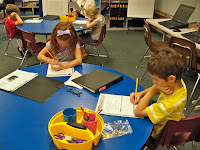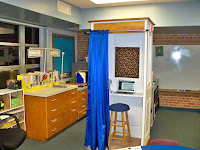We started our day by meeting, Rosie. Rosie is a Chilean Rose or Rose-hair tarantula, Grammostola rose, donated to our class by the family of a former student, Samantha. Samantha knew that in the past, I had two tarantulas as class pets. When her great Uncle decided to reduce his collection, she suggested we might make good caretakers for one of his tarantulas. I'm glad she thought of us! Rosie is definitely an exciting addition to our classes. Ask your child to tell you a little about what he/she learned about tarantulas today. If you or your child would like to learn more about Rosie, check out this link on tarantulas.
This week, our math problem solving strategy was “Use Logical Reasoning.” We have introduced this strategy before, but this week's format was different and very challenging for most of us!
Here is a challenge problem for your child to try at home with you. Your child can earn an extra star by bringing in the correct answer next week. :)
The SAGE students love to show what they have learned. One day, 12 students altogether were working on the computer during exploratory. 6 students all together were creating posters during exploratory. Four
students were doing both by creating posters ON the computer. How many
students were in this day's SAGE class?

Next, the students worked in the individual Exploratory areas. Alejandro is showing us what he knows about microscopes on his Comprehension worksheet. Caleb has begun making models of the three kinds of volcanoes our of Model Magic. Emily completed a survey on Favorite Colors. She is ready to now graph her results. Camila made a model of a cheetah and is researching information for a report on cheetahs. Abby finished her Comprehension worksheet on insects and is beginning to make a model of a lightning bug. Kelly completed the Comprehension worksheet on Gertrude Chandler Warner and the Box Car Children. Kate worked on designing her clown, rod puppet. Cora is designing a mobile about one of Eric Carle's books, Hank finished the Comprehension worksheet on the Titanic.
One of our basic academic vocabulary terms for second grade is independent. We have discussed what it means to be an independent worker and learner. Each week we encourage the students to push themselves to be as independent in their work as possible. Learning to edit, self-evaluate, self-pace and thoughtfully complete project work are goals of our Exploratory Center time. It is exciting to watch the students as they are engaged in their own center tasks.
We ended our day working on our second Creative Problem Solving lesson. This week, the students were given 20 minutes to complete the "squiggle" below.
In this task, students are asked to create a single, cohesive picture that includes all of the given squiggle figures and lines. This exercise focuses on the students' flexibility and elaboration.
Flexibility
is the ability to change your way of thinking about a problem or
situation. It is the ability to think of
alternative ideas and to adapt to different situations
- You are flexible in your thinking when you approach a complicated math problem you missed in a different way.
- You are flexible in your thinking when you can think of
indoor games to play when your birthday swim party is rained out.
Elaboration
is the process of expanding an idea by adding detail. To elaborate, you must understand the
original idea and see a way to clarify or improve it by adding specific
details.
- You are elaborating when you
add to, enlarge, enrich, or expand descriptions, designs, drawings,
explanations, instructions, reports or
stories.
- You are using elaboration
when you edit your stories and add more descriptive vocabulary and more
details.
You can see your child's finished squiggle on display during our conferences.
Have a wonderful weekend!













































